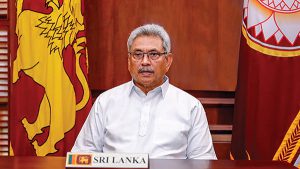Bloomberg
When Sri Lankan officials arrive in Washington to meet with the International Monetary Fund (IMF) amid an
economic and political crisis, the main question they’ll
need to answer is how the country plans to manage its billions in debt.
Sri Lanka is seeking up to
$4 billion this year to help it import essentials and pay creditors. To get any of that through the IMF’s various programs,
the government of President Gotabaya Rajapaksa must present a sustainable debt program. That’s a standard requirement for aid from the so-called lender of last resort, even if a shortage of food, fuel and medicine is pushing the country towards a humanitarian crisis.
The downward economic spiral — dwindling foreign reserves and soaring inflation — has triggered political unrest in Colombo, where Rajapaksa
has resisted calls to step down despite growing protests and
a loss of coalition partners in parliament.
The president swore in
17 new cabinet ministers. Gotabaya and his brother, Prime Minister Mahinda Rajapaksa, retained their positions. His two other siblings and a nephew didn’t receive portfolios, amid calls also
by protesters for the entire
Rajapaksa family to quit the government.
Over the weekend, the army denied speculation it planned to crack down on protesters, while the local stock exchange announced it would shut this week amid the uncertainty.
The outlook makes a default inevitable, as acknowledged by S&P Global when it downgraded Sri Lanka’s credit rating and warned of another cut if the nation misses coupon payments. Meanwhile, investors are trying to figure out how much they might recover on $12.6 billion of foreign bonds, and if there’s even profit to be made.
IMF members can access one-off emergency loans,
with few conditions, through the lender’s Rapid Credit
Facility and Rapid Financing Instrument.
However, this payout is capped at 50% of a state’s quota for a year, which in Sri Lanka’s case works out to $395 million — or $289 million in special drawing rights, the IMF’s unit of account.
 The Gulf Time Newspaper One of the finest business newspapers in the UAE brought to you by our professional writers and editors.
The Gulf Time Newspaper One of the finest business newspapers in the UAE brought to you by our professional writers and editors.
